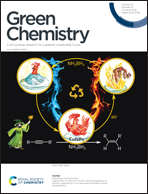Constructing single Cu–N3 sites for CO2 electrochemical reduction over a wide potential range†
Abstract
A Cu–N-doped carbon nanotube with an unsaturated coordination Cu atom (Cu–N3) was fabricated and it exhibited over 90% CO faradaic efficiency (FE) in a wide potential range from −0.42 to −0.92 V. The maximum CO FE can reach 98.7% with a high CO partial current density of 234.3 mA cm−2 in a flow cell. Theoretical calculations elucidated that the Cu–N3 site facilitated the formation of COOH*, thereby accelerating the CO2 electrochemical reduction.

- This article is part of the themed collection: 2021 Green Chemistry Hot Articles


 Please wait while we load your content...
Please wait while we load your content...